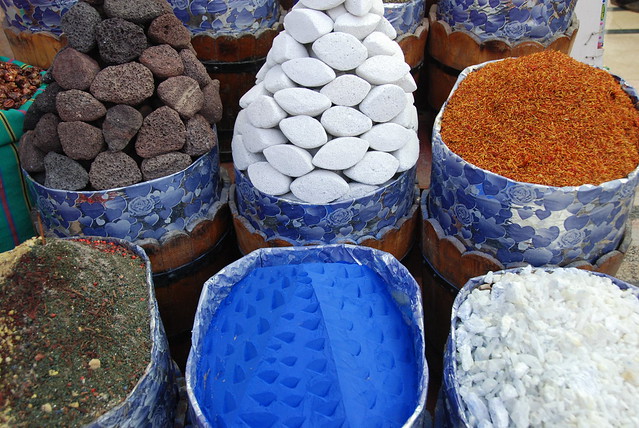
View of Aswan, overlooking the Nile
Aswan (/ˌæsˈwɑːn /, Arabic: [ʔɑˈsˁwɑːn], Arabic: أسوان Aswān, Ancient Egyptian: Swenet, Coptic: ⲥⲟⲩⲁⲛ Swān, Ancient Greek: Συήνη Syene), formerly spelled Assuan, is a city in the south of Egypt, the capital of the Aswan Governorate.
It stands on the east bank of the Nile at the first cataract and is a busy market and tourist centre. The modern city has expanded and includes the formerly separate community on the island of Elephantine.

View of from the Tombs of the Nobles on the other side of the Nile
History
Aswan is the ancient city of Swenet, which in antiquity was the frontier town of Ancient Egypt facing the south. Swenet is supposed to have derived its name from an Egyptian goddess with the same name. This goddess later was identified as Eileithyia by the Greeks and Lucina by the Romans during their occupation of Ancient Egypt because of the similar association of their goddesses with childbirth, and of which the import is "the opener". The ancient name of the city also is said to be derived from the Egyptian symbol for trade.
Archangel Michael's Coptic Orthodox Cathedral, built in the Coptic style
Because the Ancient Egyptians oriented toward the origin of the life-giving waters of the Nile in the south, Swenet was the first town in the country, and Egypt always was conceived to "open" or begin at Swenet.[citation needed] The city stood upon a peninsula on the right (east) bank of the Nile, immediately below (and north of) the first cataract of the flowing waters, which extend to it from Philae. Navigation to the delta was possible from this location without encountering a barrier.

The El-Tabia Mosque in Aswan
The stone quarries of ancient Egypt located here were celebrated for their stone, and especially for the granitic rock called Syenite. They furnished the colossal statues, obelisks, and monolithal shrines that are found throughout Egypt, including the pyramids; and the traces of the quarrymen who wrought in these 3,000 years ago are still visible in the native rock. They lie on either bank of the Nile, and a road, four miles (6 km) in length, was cut beside them from Syene to Philae.

A view along the street connecting railway station and Nile
Swenet was equally important as a military station as that of a place of traffic. Under every dynasty it was a garrison town; and here tolls and customs were levied on all boats passing southwards and northwards. Around AD 330, the legion stationed here received a bishop from Alexandria; this later became the Coptic Diocese of Syene. The city is mentioned by numerous ancient writers, including Herodotus, Strabo, Stephanus of Byzantium, Ptolemy, Pliny the Elder, De architectura,and it appears on the Antonine Itinerary. It also is mentioned in the Book of Ezekiel and the Book of Isaiah.

A street parallel to Corniche in Aswan
The latitude of the city that would become Aswan – located at 24° 5′ 23″ – was an object of great interest to the ancient geographers. They believed that it was seated immediately under the tropic, and that on the day of the summer solstice, a vertical staff cast no shadow. They noted that the sun's disc was reflected in a well at noon. This statement is only approximately correct; at the summer solstice, the shadow was only 1/400th of the staff, and so could scarcely be discerned, and the northern limb of the Sun's disc would be nearly vertical.

The Lotus-Tower near Aswan
Eratosthenes used measurements at Aswan (Elephantine) to determine the circumference of Earth, using Syene as the originating point and Alexandria as the terminal point of a measured arc (based on shadow length at the solstice).

Aswan
The Nile is nearly 3,000 yards wide above Aswan. From this frontier town to the northern extremity of Egypt, the river flows for more than 750 miles (1,210 km) without bar or cataract. The voyage from Aswan to Alexandria usually took 21 to 28 days in favourable weather.

The Nile at Aswan, seen from Elephantine Island
Climate
Aswan is Egypt's hottest, driest inhabited city[citation needed]. Aswan's climate ranges from mild in the winter to very hot in the summer with absolutely no rain all year. Maybe 1 or 2 mm of rain every 5 years[citation needed]. Aswan is one of the driest inhabited places in the world; as of early 2001, the last rain there was seven years earlier. As of 6 April 2010[update], the last rainfall was a thunderstorm on May 13, 2006. In Nubian settlements, they generally do not bother to roof all of the rooms in their houses[citation needed].

The Nile near Aswan
In winter the temperatures average from 11 degrees at night to 25 degrees during the day. In summer the temperature averages 25 degrees at night to 40 degrees during the day.















 05:46
05:46
 homesweethome
homesweethome

 Posted in:
Posted in: 








0 意見:
Post a Comment